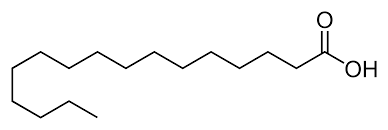HI! I’M ELEMENT AI.
Palmitic Acid

Product Description
Palmitic acid is a saturated fatty acid.. It's commonly found in both animal and plant fats.
Product:
Palmitic Acid
CAS:
57-10-3
Synonym:
Hexadecanoic Acid; 1-Pentadecanecarboxylic Acid; Cetylic Acid
Structure:

Typical Characteristics
Appearance
White, waxy solid in flake, bead or powder form
Boiling point
351 °C
Density
0.853 g/cm3
Flash Point
205 °C
Melting point
62.5 °C
Molecular Weight
256.42
Odor
Mild fatty
Purity
98 %
Refractive index
1.4273
Uses, Applications & Markets
Key applications
get a quote
We Offer Palmitic Acid
in various grades
A few of the grades available are listed below:



Palmitic Acid used in many
industry applications
Palmitic acid is a chemical compound with various industrial applications. Here's a list of some of its uses:
- Food Industry: Palmitic acid is used in the food industry as a food additive and ingredient. It is found naturally in many animal and vegetable fats and oils, including palm oil, coconut oil, and butter. Palmitic acid provides flavor, texture, and stability to food products.
- Personal Care Products: It is used in the formulation of personal care products, including soaps, lotions, creams, and cosmetics. Palmitic acid serves as an emollient, moisturizer, and thickening agent, helping to soften and hydrate the skin and hair.
- Pharmaceuticals: Palmitic acid is used in pharmaceutical formulations as an excipient and emulsifier. It is used in the production of oral medications, topical ointments, and suppositories. Palmitic acid helps improve the solubility, stability, and bioavailability of active pharmaceutical ingredients.
- Industrial Lubricants: It is used as a lubricant in various industrial applications, including metalworking fluids, hydraulic fluids, and cutting oils. Palmitic acid provides lubrication, corrosion protection, and heat dissipation in machining and metal forming operations.
- Surfactants: Palmitic acid and its derivatives are used as surfactants and emulsifiers in various industrial and household products, including detergents, cleaning agents, and cosmetics. They help reduce surface tension, improve wetting, and stabilize emulsions.
- Cosmetics: Palmitic acid is used in the cosmetics industry as a raw material for the production of skincare products, hair care products, and makeup. It functions as a thickener, emulsifier, and moisturizer in cosmetic formulations, enhancing their texture and performance.
- Plastics: Palmitic acid is used as a plasticizer in the production of plastics and elastomers. It improves the flexibility, softness, and processability of plastic materials, making them suitable for applications such as packaging films, molded parts, and flexible tubing.
- Textile Processing: It is used in textile processing as a lubricant, softener, and sizing agent. Palmitic acid helps improve the handling properties of textile fibers, enhance fabric softness, and increase dye uptake during the dyeing process.
- Biomedical Research: Palmitic acid is used in biomedical research as a solvent, vehicle, and model compound. It is used in cell culture experiments, drug delivery systems, and lipid-based formulations for studying biological processes and drug interactions.
- Animal Feed: Palmitic acid is used as a feed additive in animal nutrition to improve the energy content and palatability of feed formulations. It is added to livestock feed, pet food, and aquafeed to enhance animal growth, health, and feed efficiency.